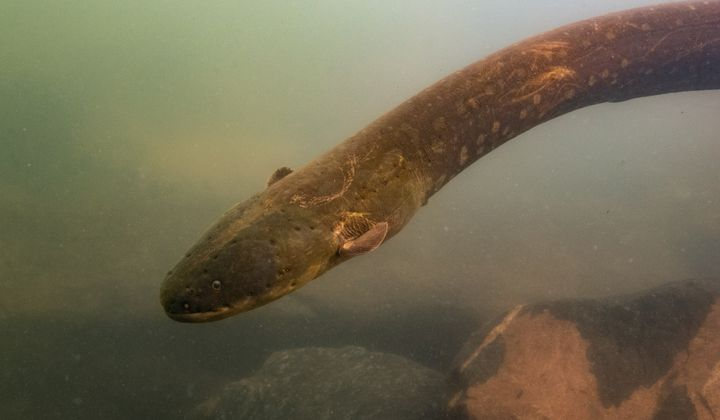
The Volta’s electric eel, Electrophorus voltai, emits the strongest shocks of any animal on Earth. Although these eels were thought to be loners, the species was recently seen hunting in a group. (L. Sousa)
Today, a new paper in Ecology and Evolution challenges what researchers know about eels’ supposed loner behavior. Researchers have now discovered a group of electric eels working together to attack small fish in the Brazilian Amazon River basin. The eels, which are a type of knifefish rather than true eels, were once thought to be loners who preyed alone.
“This is an extraordinary discovery,” said Dr. C. David de Santana, senior author of the paper and fish research associate at the Smithsonian’s National Museum of Natural History. “Nothing like this has ever been documented in electric eels.”
The electric fish herd tiny fish called tetras into churning balls. Then several eels separate from the writhing mass to jolt the tetras into becoming dinner. (Douglas Bastos)
Volta’s electric eel, Electrophorus voltai, emits the strongest electric current of any animal on Earth. It is also the species found pack hunting in a lake bordering the Iriri River in Brazil.
The eels hunt at twilight by swimming in circles around small fish called tetras, forcing the tetras into small, churning balls. Bands of eels then separate from the eel pack to shock tetras with electric charges strong enough to fling the tiny fish out of the water.
“In theory, if 10 of them discharged at the same time, they could be producing up to 8,600 volts of electricity,” said de Santana. “That’s around the same voltage needed to power 100 light bulbs.”
After the tetras are stunned and motionless, the eels can gorge on a buffet of defenseless prey. Unlike loner electric eel species, which normally sneak up on one sleeping fish at a time, the social Volta’s electric eels were able to easily capture many tetras at once.
Knowing more about how Volta’s electric eels behave in the wild is important because their habitats in the Amazon River basin are increasingly threatened by climate change, fire and deforestation. As biodiversity in that region decreases, many undiscovered species, their unique behaviors and their habitats are in danger of disappearing.
“This paper is an example of how much we still don’t know — how many organisms whose life histories we don’t yet understand,” said de Santana.
https://www.smithsonianmag.com/blogs/national-museum-of-natural-history/2021/01/14/shocking-study-finds-electric-eels-hunt-together/